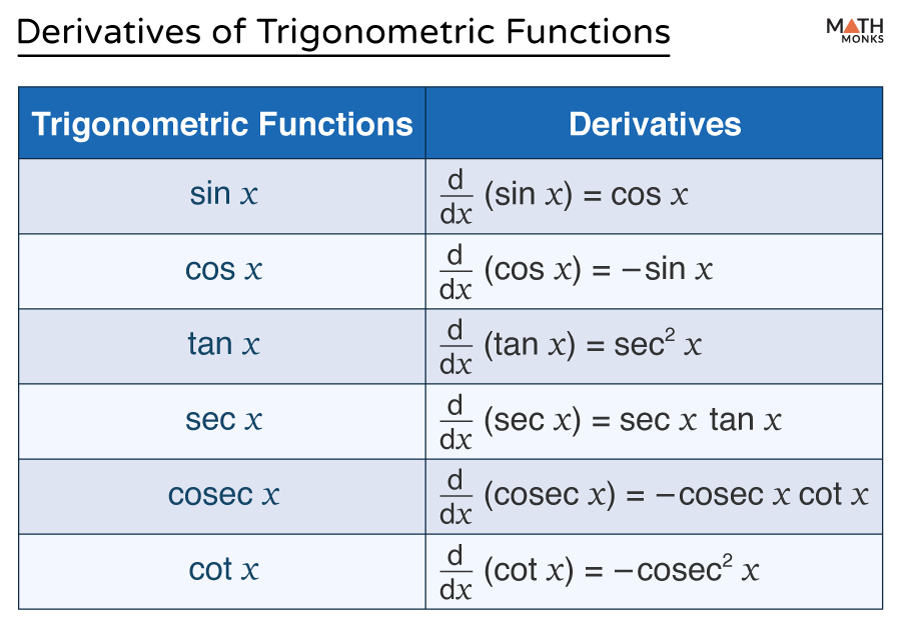Finding the derivative of a trigonometric function means differentiating the trigonometric function with respect to a given variable. These derivatives are widely used in physics and engineering to analyze waveforms, determine velocity and acceleration in harmonic motion, study periodic patterns, and perform Fourier analysis.
Below are the differentiation formulas of the six basic trigonometric functions:
Let us now find the derivative of the 6 trigonometric functions.
Sine Function (sin x)
The derivative of the sine function is the cosine function.
Formula
${\dfrac{d}{dx}\left( \sin x\right) =\cos x}$
Proof
Using the first principle of differentiation:
${\dfrac{d}{dx}\left( \sin x\right)}$
= ${\lim _{h\rightarrow 0}\dfrac{\sin \left( x+h\right) -\sin x}{\left( x+h\right) -x}}$ …..(i)
As we know, sin(x + y) = sin x ⋅ cos y + cos x ⋅ sin y
Here,
sin(x + h) = sin x ⋅ cos h + cos x ⋅ sin h
Now, from (i), we get
${\lim _{h\rightarrow 0}\dfrac{\sin x\cos h+\cos x\sin h-\sin x}{x+h-x}}$
= ${\lim _{h\rightarrow 0}\dfrac{\sin x\left( \cos h-1\right) +\cos x\sin h}{h}}$
= ${\lim _{h\rightarrow 0}\left( \dfrac{\cos h-1}{h}\right) \left( \sin x\right) +\lim _{h\rightarrow 0}\left( \dfrac{\sin h}{h}\right) \left( \cos x\right)}$
= (0)(sin x) + (1)(cos x)
= cos x
Thus, ${\dfrac{d}{dx}\left( \sin x\right)}$ = cos x
Cosine Function (cos x)
The derivative of the cosine function is the sine function.
Formula
${\dfrac{d}{dx}\left( \cos x\right) =-\sin x}$
The negative sign shows the periodic nature of the cosine function.
Proof
Using the first principle of differentiation:
${\dfrac{d}{dx}\left( \cos x\right)}$
= ${\lim _{h\rightarrow 0}\dfrac{\cos \left( x+h\right) -\cos x}{\left( x+h\right) -x}}$ …..(i)
As we know, cos(x + y) = cos x ⋅ cos y + sin x ⋅ sin y
Here,
cos(x + h) = cos x ⋅ cos h + sin x ⋅ sin h
Now, from (i), we get
${\lim _{h\rightarrow 0}\dfrac{\cos x\cos h+\sin x\sin h-\cos x}{x+h-x}}$
= ${\lim _{h\rightarrow 0}\dfrac{\cos x\left( \cos h-1\right) +\sin x\sin h}{h}}$
= ${\lim _{h\rightarrow 0}\left( \dfrac{\cos h-1}{h}\right) \left( \cos x\right) +\lim _{h\rightarrow 0}\left( \dfrac{\sin h}{h}\right) \left( \sin x\right)}$
= (0)(cos x) – (1)(sin x)
= -sin x
Thus, ${\dfrac{d}{dx}\left( \cos x\right)}$ = -sin x
Tangent Function (tan x)
The derivative of the tangent function is the square of the secant function.
Formula
${\dfrac{d}{dx}\left( \tan x\right) =\sec ^{2}x}$
This derivative is valid for all x except where tan x is undefined [${x=\dfrac{\pi }{2}+n\pi}$, n ∈ ℤ]
Proof
Here, we will use the quotient rule:
${\dfrac{d}{dx}\left( \dfrac{u}{v}\right) =\dfrac{v\dfrac{du}{dx}-u\dfrac{dv}{dx}}{v^{2}}}$
As we know, ${\tan x=\dfrac{\sin x}{\cos x}}$
Here,
${\dfrac{d}{dx}\left( \tan x\right)}$
= ${\dfrac{d}{dx}\left( \dfrac{\sin x}{\cos x}\right)}$
= ${\dfrac{\cos x\dfrac{d}{dx}\left( \sin x\right) -\sin x\dfrac{d}{dx}\left( \cos x\right) }{\cos ^{2}x}}$
= ${\dfrac{\cos x\cdot \cos x-\sin x\cdot \left( -\sin x\right) }{\cos ^{2}x}}$
= ${\dfrac{\cos ^{2}x+\sin ^{2}x}{\cos ^{2}x}}$ …..(i)
Using the Pythagorean identity, sin2 x + cos2 x = 1
From (i), we get
${\dfrac{1}{\cos ^{2}x}}$
= sec2 x
Thus, ${\dfrac{d}{dx}\left( \tan x\right)}$ = sec2 x
Secant Function (sec x)
The derivative of the secant function is the product of secant and tangent functions.
Formula
${\dfrac{d}{dx}\left( \sec x\right) =\sec x\tan x}$
Proof
Using the definition of secant as the reciprocal of cosine:
sec x = ${\sec x=\dfrac{1}{\cos x}}$
Here,
${\dfrac{d}{dx}\left( \sec x\right)}$
= ${\dfrac{d}{dx}\left( \dfrac{1}{\cos x}\right)}$
Now, by using the quotient rule,
= ${\dfrac{\cos x\dfrac{d}{dx}\left( 1\right) -\left( 1\right) \dfrac{d}{dx}\left( \cos x\right) }{\cos ^{2}x}}$
= ${\dfrac{\left( \cos x\right) \left( 0\right) -\left( -\sin x\right) }{\cos ^{2}x}}$
= ${\dfrac{\sin x}{\cos ^{2}x}}$
= ${\dfrac{1}{\cos x}\cdot \dfrac{\sin x}{\cos x}}$
= sec x ⋅ tan x
Thus, ${\dfrac{d}{dx}\left( \sec x\right)}$ = sec x ⋅ tan x
Cosecant Function (cosec x)
The derivative of the cosecant function is the negative product of the cosecant and the cotangent functions.
Formula
${\dfrac{d}{dx}\left( \text{cosec}\, x\right) =\text{cosec}\, x\cot x}$
Proof
Using the definition of cosecant as the reciprocal of sine:
cosec x = ${\text{cosec}\, x=\dfrac{1}{\sin x}}$
Here,
${\dfrac{d}{dx}\left( \text{cosec}\, x\right)}$
= ${\dfrac{d}{dx}\left( \dfrac{1}{\sin x}\right)}$
Now, by using the quotient rule,
= ${\dfrac{\sin x\dfrac{d}{dx}\left( 1\right) -\left( 1\right) \dfrac{d}{dx}\left( \sin x\right) }{\sin ^{2}x}}$
= ${\dfrac{\left( \sin x\right) \left( 0\right) -\left( \cos x\right) }{\sin ^{2}x}}$
= ${-\dfrac{\cos x}{\sin ^{2}x}}$
= ${-\dfrac{1}{\sin x}\cdot \dfrac{\cos x}{\sin x}}$
= -cosec x ⋅ cot x
Thus, ${\dfrac{d}{dx}\left( \text{cosec}\, x\right)}$ = -cosec x ⋅ cot x
Cotangent Function (cot x)
The derivative of the cotangent function is the negative square of the cosecant function.
Formula
${\dfrac{d}{dx}\left( \cot x\right) =-\text{cosec} ^{2}\, x}$
Proof
Using the definition of cotangent as the ratio of cosine to sine:
${\cot x=\dfrac{\cos x}{\sin x}}$
Here,
${\dfrac{d}{dx}\left( \cot x\right)}$
= ${\dfrac{d}{dx}\left( \dfrac{\cos x}{\sin x}\right)}$
Now, by using the quotient rule,
= ${\dfrac{\sin x\dfrac{d}{dx}\left( \cos x\right) -\cos x\dfrac{d}{dx}\left( \sin x\right) }{\sin ^{2}x}}$
= ${\dfrac{\sin x\cdot \left( -\sin x\right) -\cos x\cdot \cos x}{\sin ^{2}x}}$
= ${\dfrac{-\sin ^{2}x-\cos ^{2}x}{\sin ^{2}x}}$
= ${\dfrac{-\left( \sin ^{2}x+\cos ^{2}x\right) }{\sin ^{2}x}}$ …..(i)
Using the Pythagorean identity, sin2 x + cos2 x = 1
From (i), we get
${\dfrac{-1}{\sin ^{2}x}}$
= -cosec2 x
Thus, ${\dfrac{d}{dx}\left( \cot x\right)}$ = -cosec2 x
Solved Examples
![]() Find the derivative of f(x) = sin x + cos x
Find the derivative of f(x) = sin x + cos x
Solution:
![]()
As we know,
(sin x)’ = cos x and (cos x)’ = – sin x
Here,
f’(x) = (sin x + cos x)’
= (sin x)’ + (cos x)’
= cos x – sin x
![]() Find the slope of the tangent to g(x) = tan x at x = ${\dfrac{\pi }{4}}$
Find the slope of the tangent to g(x) = tan x at x = ${\dfrac{\pi }{4}}$
Solution:
![]()
As we know,
(tan x)’ = sec2 x
At x = ${\dfrac{\pi }{4}}$, g’(x) = ${\sec ^{2}\left( \dfrac{\pi }{4}\right)}$
Since ${\sec \left( \dfrac{\pi }{4}\right) =\sqrt{2}}$
⇒ ${\sec ^{2}\left( \dfrac{\pi }{4}\right) =2}$
Thus, ${g’\left( \dfrac{\pi }{4}\right) =2}$
![]() Differentiate f(x) = x2 sin x
Differentiate f(x) = x2 sin x
Solution:
![]()
As we know, the product rule is
(uv)’ = v(u’) + u(v’)
Here, u = x2 and v = sin x
⇒ u’ = 2x and v’ = cos x
Thus, f’(x) = (x2 sin x)’
= sin x ⋅ (x2)’ + x2 ⋅ (sin x)’
= (sin x)(2x) + (x2)(cos x)= 2x sin x + x2 cos x

